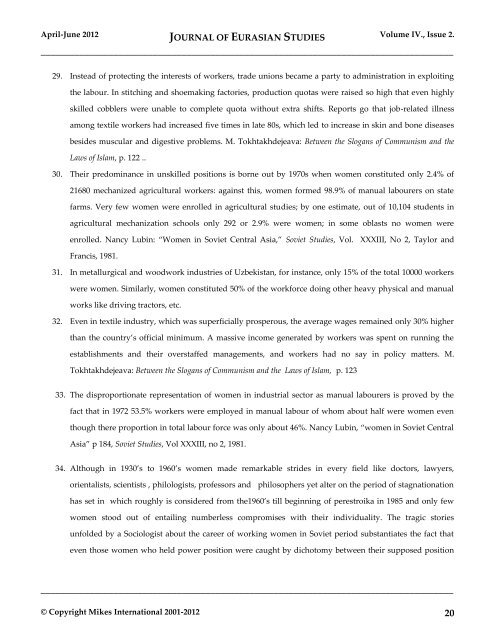You also want an ePaper? Increase the reach of your titles
YUMPU automatically turns print PDFs into web optimized ePapers that Google loves.
April-June 2012 JOURNAL OF EURASIAN STUDIES Volume IV., Issue 2.<br />
_____________________________________________________________________________________<br />
29. Instead <strong>of</strong> protecting the interests <strong>of</strong> workers, trade unions became a party to administration in exploiting<br />
the labour. In stitching and shoemaking factories, production quotas were raised so high that even highly<br />
skilled cobblers were unable to complete quota without extra shifts. Reports go that job-related illness<br />
among textile workers had increased five times in late 80s, which led to increase in skin and bone diseases<br />
besides muscular and digestive problems. M. Tokhtakhdejeava: Between the Slogans <strong>of</strong> Communism and the<br />
Laws <strong>of</strong> Islam, p. 122 ..<br />
30. Their predominance in unskilled positions is borne out by 1970s when women constituted only 2.4% <strong>of</strong><br />
21680 mechanized agricultural workers: against this, women formed 98.9% <strong>of</strong> manual labourers on state<br />
farms. Very few women were enrolled in agricultural studies; by one estimate, out <strong>of</strong> 10,104 students in<br />
agricultural mechanization schools only 292 or 2.9% were women; in some oblasts no women were<br />
enrolled. Nancy Lubin: “Women in Soviet Central Asia,” Soviet <strong>Studies</strong>, Vol. XXXIII, No 2, Taylor and<br />
Francis, 1981.<br />
31. In metallurgical and woodwork industries <strong>of</strong> Uzbekistan, for instance, only 15% <strong>of</strong> the total 10000 workers<br />
were women. Similarly, women constituted 50% <strong>of</strong> the workforce doing other heavy physical and manual<br />
works like driving tractors, etc.<br />
32. Even in textile industry, which was superficially prosperous, the average wages remained only 30% higher<br />
than the country’s <strong>of</strong>ficial minimum. A massive income generated by workers was spent on running the<br />
establishments and their overstaffed managements, and workers had no say in policy matters. M.<br />
Tokhtakhdejeava: Between the Slogans <strong>of</strong> Communism and the Laws <strong>of</strong> Islam, p. 123<br />
33. The disproportionate representation <strong>of</strong> women in industrial sector as manual labourers is proved by the<br />
fact that in 1972 53.5% workers were employed in manual labour <strong>of</strong> whom about half were women even<br />
though there proportion in total labour force was only about 46%. Nancy Lubin, “women in Soviet Central<br />
Asia” p 184, Soviet <strong>Studies</strong>, Vol XXXIII, no 2, 1981.<br />
34. Although in 1930’s to 1960’s women made remarkable strides in every field like doctors, lawyers,<br />
orientalists, scientists , philologists, pr<strong>of</strong>essors and philosophers yet alter on the period <strong>of</strong> stagnationation<br />
has set in which roughly is considered from the1960’s till beginning <strong>of</strong> perestroika in 1985 and only few<br />
women stood out <strong>of</strong> entailing numberless compromises with their individuality. The tragic stories<br />
unfolded by a Sociologist about the career <strong>of</strong> working women in Soviet period substantiates the fact that<br />
even those women who held power position were caught by dichotomy between their supposed position<br />
_____________________________________________________________________________________<br />
© Copyright Mikes International 2001-2012 20
















